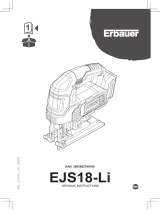
ENGLISH en
13
Original instructions
1. Declaration of Conformity
We declare under our sole responsibility: These
cordless sabre saws, identied by type and serial
number *1), comply with all relevant requirements
of the directives *2) and standards *3). Technical
le at *4) - see page 3.
2. SpeciedUse
The tool is suitable for sawing wood, metals,
plastics or similar materials such as hard rubber,
bre glass, etc.
The user bears sole responsibility for any damage
caused by improper use.
Generally accepted accident prevention
regulations and the enclosed safety information
must be observed.
3. General Safety Instructions
For your own protection and for the
protection of your power tool, pay
attention to all parts of the text that are
marked with this symbol!
WARNING – Read the operating
instructions to reduce the risk of injury.
WARNING–Readallsafetywarnings,
instructions,illustrationsand
specicationsprovidedwiththispowertool.
Failure to follow all instructions listed below may
result in electric shock, re and/or serious injury.
Saveallwarningsandinstructionsforfuture
reference.
Always include these documents when passing on
your power tool.
4. Special Safety Instructions
Holdthepowertoolbyinsulatedgripping
surfaces,whenperforminganoperation
wherethecuttingaccessorymaycontact
hiddenwiring. Cutting accessory contacting a
"live" wire may make exposed metal parts of the
power tool "live" and could give the operator an
electric shock.
Useclampsoranotherpracticalwaytosecure
andsupporttheworkpiecetoastableplatform.
Holding the work by your hand or against the body
leaves it unstable and may lead to loss of control.
Whennotinuse,lockthemachinewiththe
switch-onlock(4)topreventitfromswitching
oninadvertently.
Removethebatterypackfromthemachine
beforeanyadjustments,conversions,
servicingorcleaningareperformed.
Beforettingthebatterypack,makesurethat
themachineisswitchedo.
Always wear protective goggles, gloves, and sturdy
shoes when working with this tool.
Ensure that the spot where you wish to work is free
of powercables,gaslinesorwaterpipes (e.g.
using a metal detector).
When sawing water pipes, ensure that they do not
contain any water.
Wearearprotectorswhenworkingforlong
periodsoftime. High noise levels over a
prolonged period of time may aect your hearing.
Materials that generate dusts or vapours that may
be harmful to health (e.g. asbestos) must not be
processed.
Do not try to saw extremely small workpieces.
Only use sharp, undamaged saw blades. Do not
use any cracked saw blades or blades that have
changed their shape.
Only use the machine with the guide tted. For
sawing, the guide must make secure contact with
the workpiece.
Always hold the machine with both hands using the
handles provided, stand securely and concentrate.
Danger of injury due to the sharp saw blade.
Do not touch the moving saw blade! Remove chips
and similar material only with the machine at
standstill.
Do not reach under the workpiece while the
machine is in operation.
Risk of crushing during operation! Keep your
ngers away from the area of the saw blade
tensioning device (1).
LED working light (2): Do not observe the LED
radiation directly with optical instruments.
CAUTION Do not stare at operating lamp.
Protect battery packs from water and
moisture!
Do not expose battery packs to naked
ame!
Do not use faulty or deformed battery packs!
Do not open battery packs!
Do not touch or short-circuit battery packs!
Slightly acidic, ammable uid may leak
from defective li-ion battery packs!
If battery uid leaks out and comes into
contact with your skin, rinse immediately
with plenty of water. If battery uid leaks out
and comes into contact with your eyes, wash them
with clean water and seek medical attention
immediately.
If the machine is defective, remove the battery
pack from the machine.








